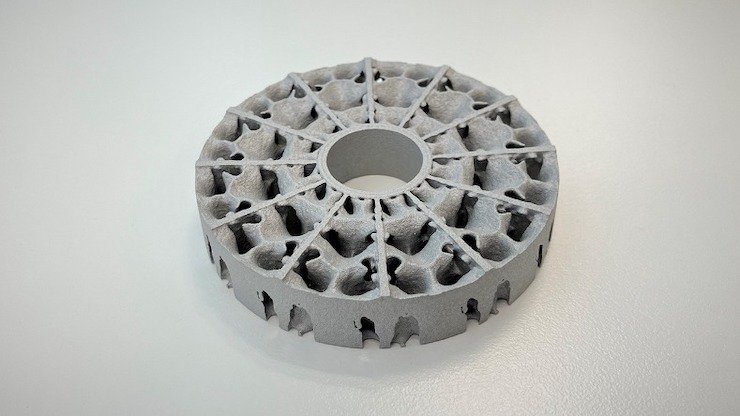Ricoh is leveraging Siemens Digital Industries Software’s Additive Manufacturing Network capabilities to maximise the efficiency of its aluminium Binder Jetting Technology (BJT).
Announced in 2021, Ricoh’s binder jetting process has been designed to ‘realise the ambition’ of end-use metal parts production with 3D printing technology.
Ricoh’s Binder Jetting Technology applies the company’s inkjet printing technology, with aluminium alloy powder being spread out over the modelling area before being solidified with a ‘specially formulated’ binder to shape the part. After parts are built up layer-by-layer, the green part is sintered in a furnace to create a densified, end-use component that can be used as is, unless other downstream processes are required.
As it works to commercialise its Binder Jetting Technology, Ricoh has aligned with Siemens to optimise the workflow for production preparation, planning, scheduling, and production management. With Siemens’ Additive Manufacturing Network, Ricoh and its future users will be able to assess designs, optimise critical properties, manage digital inventories, manage quotes, and track orders, while also being able to analyse costs and scheduling.
Workflow optimisation will be aided by Siemens Additive Manufacturing Network online order-to-delivery collaboration platform, while Siemens’ Brownfield Connectivity offering will help Ricoh to collect and store process information for quality stabilisation and production control.
“The production of aluminium parts is a holy grail for the additive industry, and we’re delighted that Ricoh has chosen Siemens’ Additive Manufacturing Network capabilities from the Siemens Xcelerator portfolio of industry software to help them commercialise a much sought-after process,” commented Zvi Feuer, Senior Vice President, Digital Manufacturing Software, Siemens Digital Industries Software. “Our collaboration with Ricoh will apply its expertise in additive manufacturing with our knowledge and experience in delivering additive-specific operations management technology across a wide spectrum of industries – from order capture, production planning, and manufacturing to part delivery transaction closure. Together, Siemens and Ricoh are working to deliver repeatability and consistency at the scale needed to truly take advantage of using robust and repeatable aluminium additively manufactured parts in the commercial world.”
Tokutaro Fukushima, General Manager of Additive Manufacturing Business Center, Ricoh Futures Business Unit, Ricoh Company, Ltd., added: “Ricoh will enable our customers to manufacture innovative aluminium components that have never been produced before by any process and will work with them to realise new customer value in the area of electrification of EVs and other forms of mobility. By combining Siemens’ powerful solutions and knowledge with Ricoh’s aluminium BJT, we will be able to provide our customers with highly reliable and practical systems for mass production applications. We hope to promote electrification together with our customers and contribute to solving social issues such as realising a zero-carbon society.”
Source link
credite

